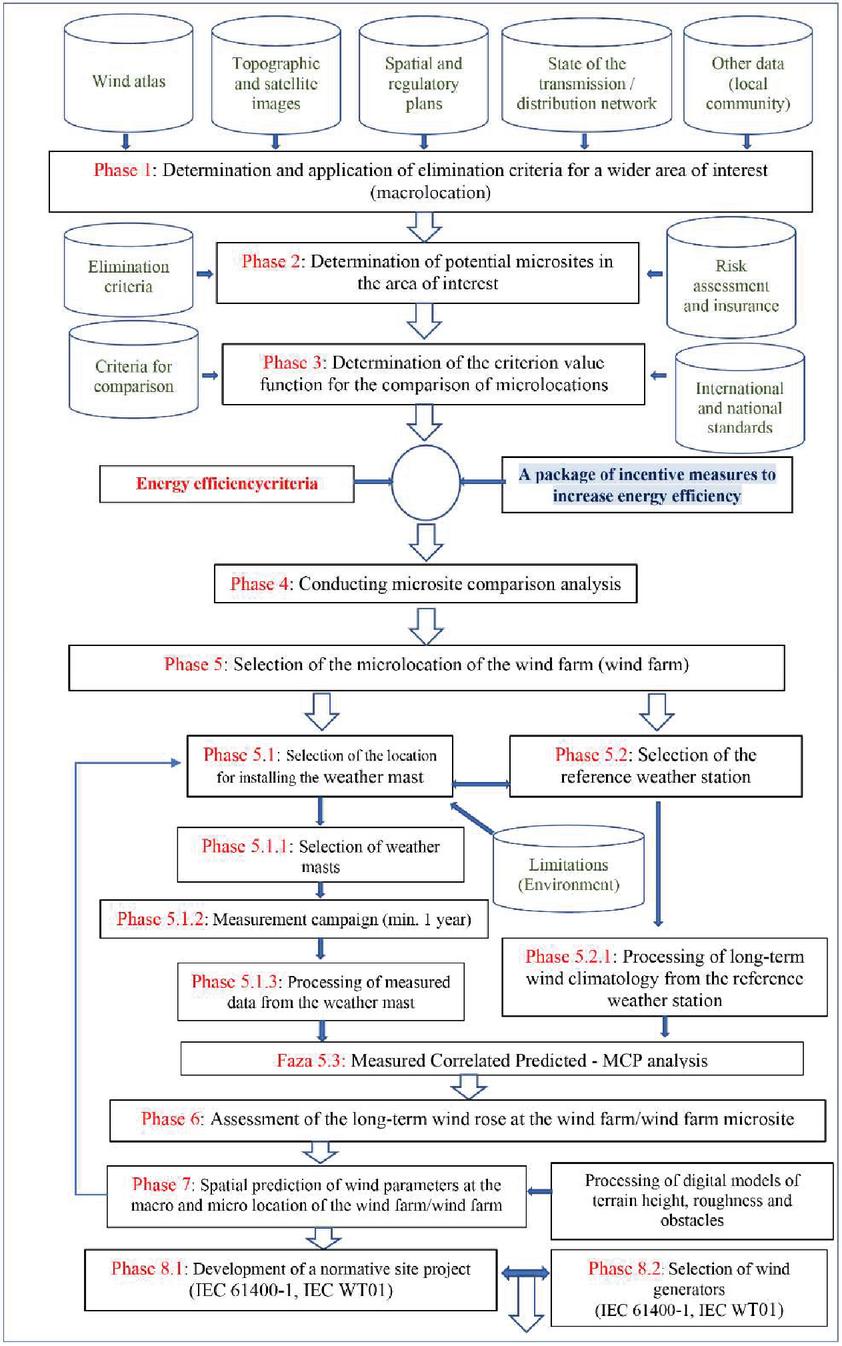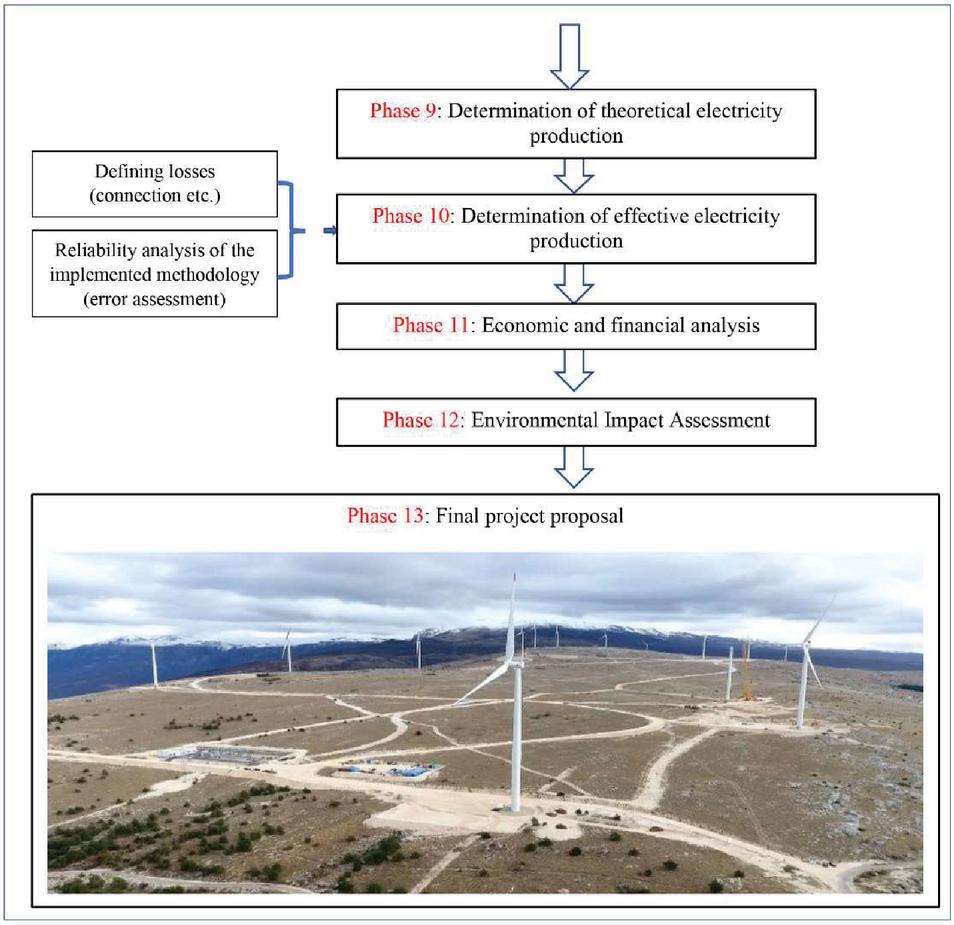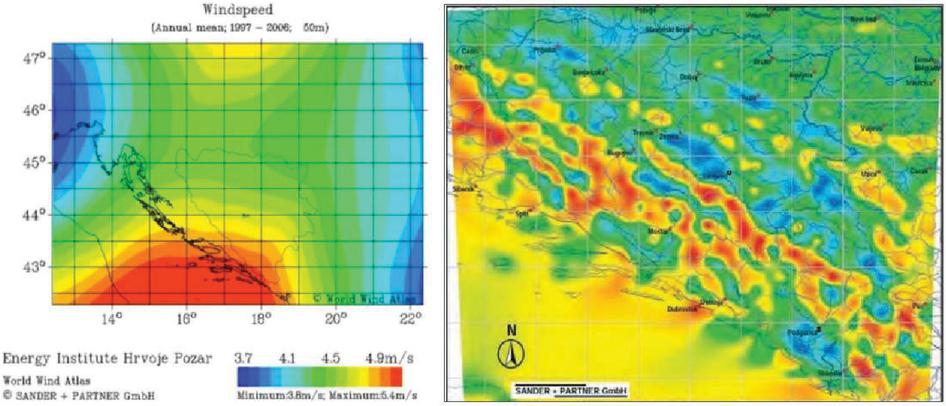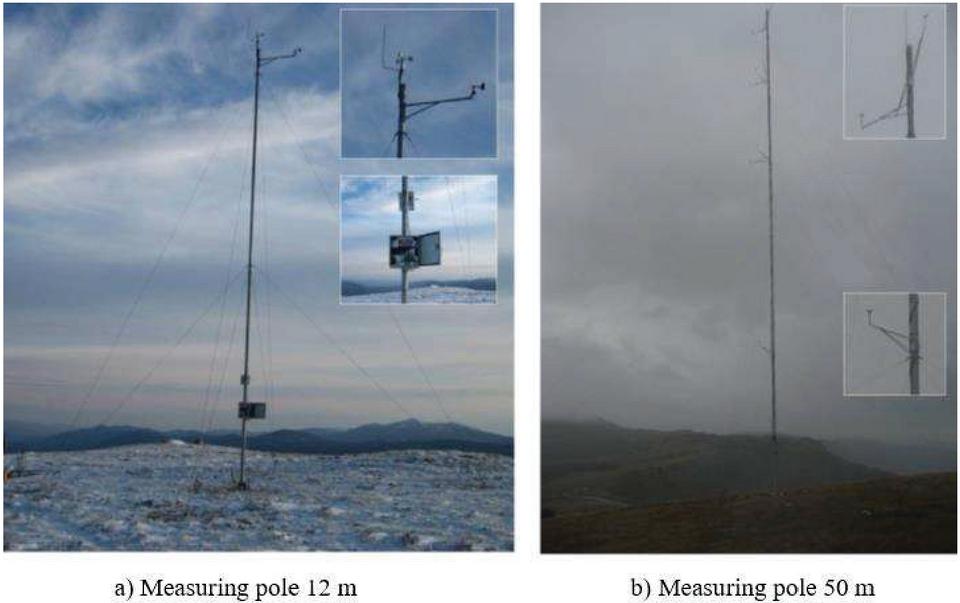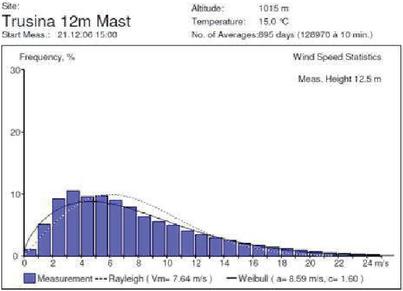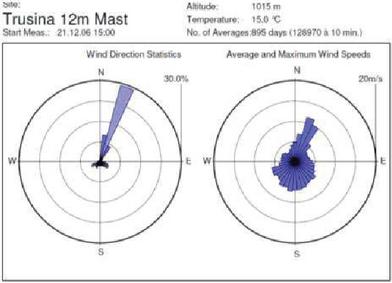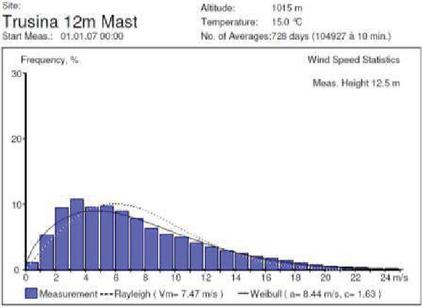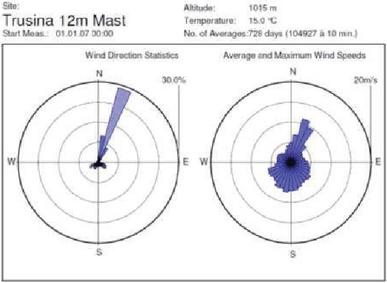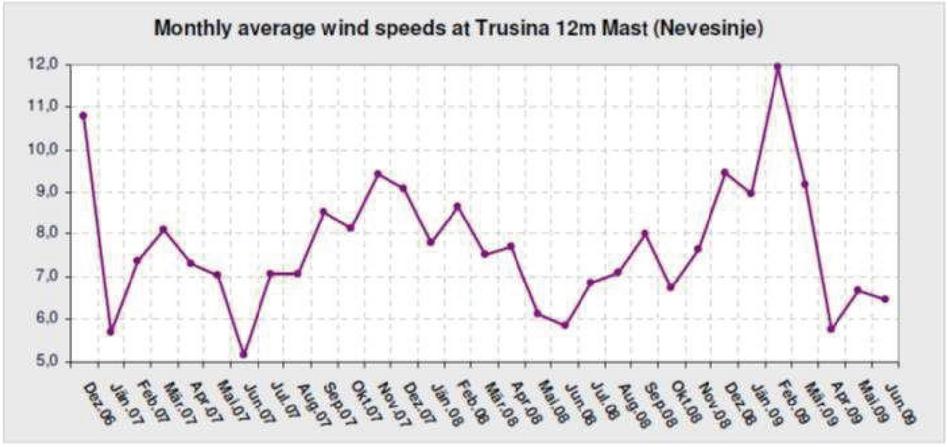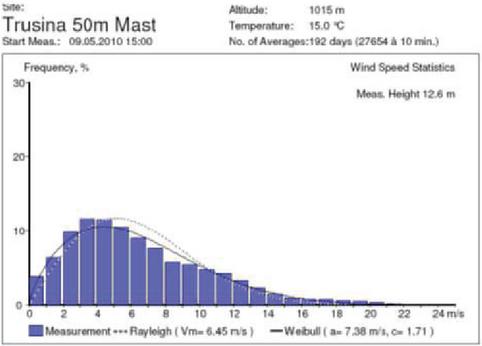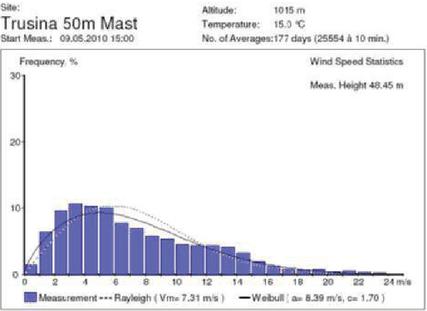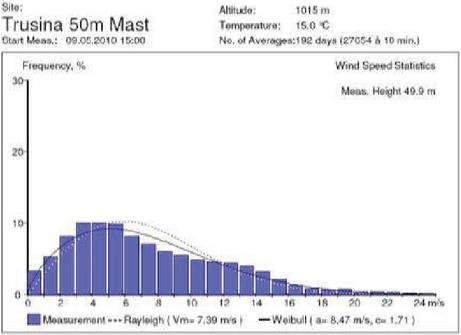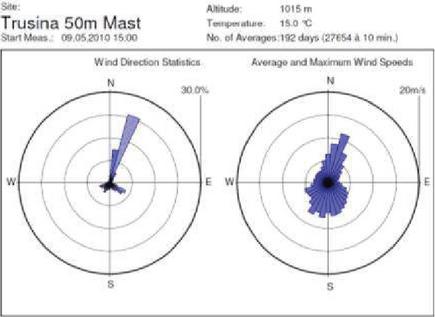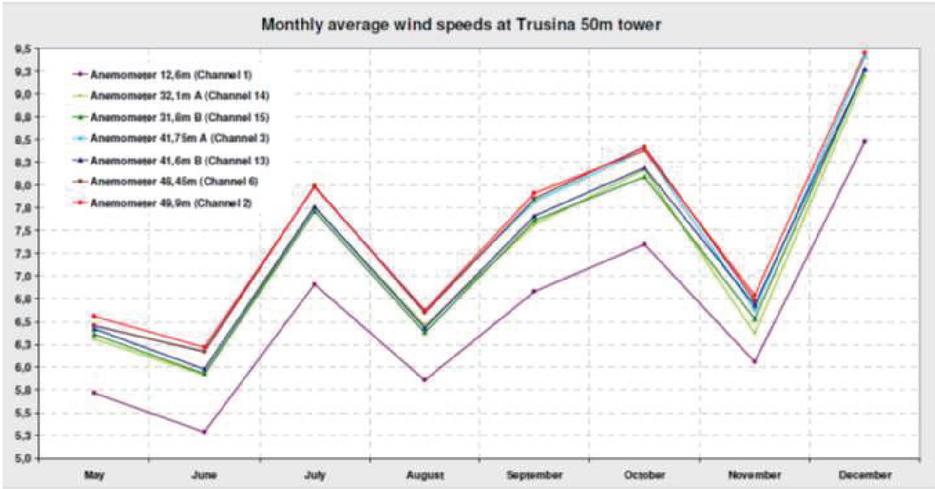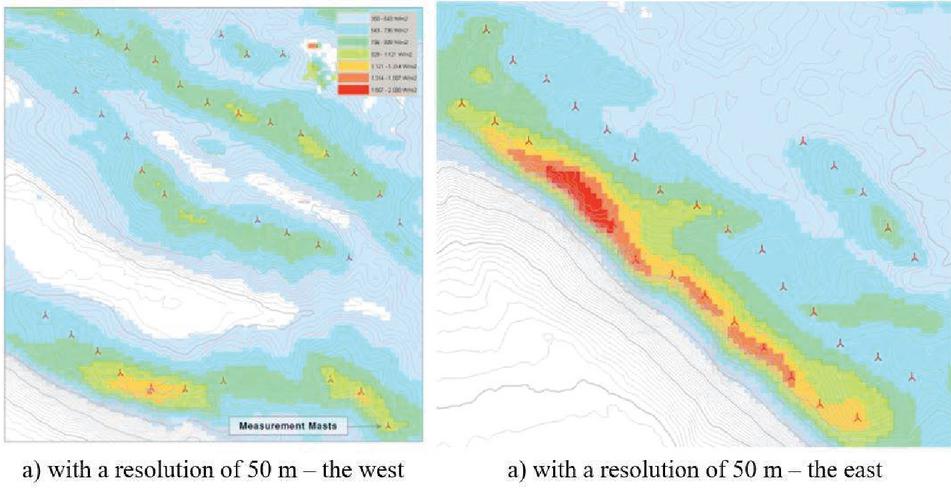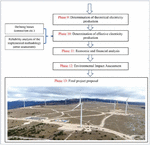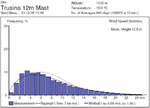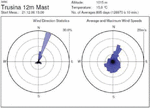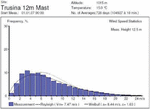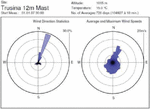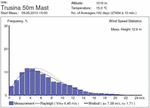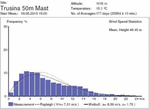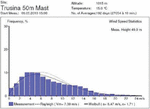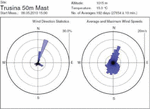Assessment of Wind Energy Potential and Selection of Wind Park Location on the Example of the Trusina Mountain Ridge (Republic of Srpska, Bosnia and Herzegovina)
Zdravko Milovanović1, Dejan Branković1,* and Valentina Janičić-Milovanović2
1Department of Hydro and Thermal Engineering, University of Banja Luka, Faculty of Mechanical Engineering Banja Luka, Stepe Stepanovića71, Republika Srpska, Bosnia and Herzegovina
2Independent Researcher, Solunska 8a, 78000 Banja Luka, Bosnia and Herzegovina
E-mail: zdravko.milovanovic@mf.unibl.org; dejan.brankovic@mf.unibl.org; milovanovicv88@gmail.com
*Corresponding Author
Received 01 October 2024; Accepted 18 October 2024
Abstract
By signing international declarations and conventions, Bosnia and Herzegovina undertook to promote the production of energy from renewable sources, including wind energy. Designing a wind turbine system at a location requires knowledge of information about wind characteristics and resources, including information about turbulence. A wind energy potential estimates contain a high degree of uncertainty. Using wind data, including the average wind speed, an estimate of resources and possible electricity production is defined, as well as a location specification for one or more turbines. The successful development and location of wind parks depends on the accuracy of the assessment. The end result is a defined possible number of wind turbines on the site and a proposal for their arrangement with micro locations for each of the wind turbines of the future wind park. Within this paper, an example of the analysis of the Trusina wind park, located on the mountain ridge of the same name on the border of the local communities of Nevesinje and Berkovići, Republic of Srpska – Bosnia and Herzegovina, is given. The measurement campaign and a more detailed analysis of the collected data from all measurement stations in Bosnia and Herzegovina will be of great importance and will serve in determining the most favorable locations for the installation of production capacities based on wind energy. The conducted analysis of wind potential on the example of the Trusina mountain ridge represents a small contribution to solving this issue.
Keywords: Wind, potential, potential measurement, analysis, use.
1 Introduction
Modern assessments of wind energy potential have been carried out since the late 1970s, when the first wind parks were built. When choosing a location for the construction of a wind farm, the most important criterion is undeniably the wind potential of the location, Figures 1 and 2. The importance of this criterion is reflected in the simple fact that the wind power depends on the third power of the speed. Thus, an error of 10% in speed entails an error of about 30% in available power. Due to technological limitations, for real turbines the exponent of the dependence of the produced energy on the average wind speed ranges between 2 and 2.5 and still strongly affects the economics of the wind farm construction project. Various organizations create maps (wind atlases) with an assessment of wind potential for areas with active wind energy development. As a first step in the investigation of potential wind locations, an analysis of such maps can be taken, but the lack of accuracy and detail make them useful only for the initial selection of locations for wind speed measurements.
Figure 1 Corrected diagram of activities for the design of wind farms – Part I.
Figure 2 Corrected diagram of activities for the design of wind farms – Part II.
The choice of micro locations for setting up measuring stations for measuring wind energy potential was primarily based on global experiences and instructions in the field of electricity production from wind as a renewable source, on available indicative measurements of the Hydrometeorological Institute of the Republic of Srpska and the Federal Hydrometeorological Institute of Bosnia and Herzegovina, on available data from the electronic Atlas of winds for Bosnia and Herzegovina (Atlas) [1–3], as well as data obtained from conversations with the local population during field visits. The atlas is based on meteorological data collected for 30 years in the period from 1978 to 2007, based on satellite images. Figure 3 gives a general overview of the average annual wind speed in the period from 1978 to 2007 for the entire area of Bosnia and Herzegovina, [1, 2]. By increasing the number of measurements at the locations themselves, as well as data obtained from already built wind farms, wind maps improve over time. This does not mean that these maps will completely replace the need for measurements at the locations themselves. In order to estimate the energy production of wind turbines, measurements of wind properties must first be made at the location itself. This is primarily what meteorological stations equipped with anemometers, devices for measuring wind direction, and sometimes sensors for measuring temperature, pressure and relative air humidity are used for. Data from meteorological stations must be based on measurements for at least one year (preferably 3 to 5 years), in order to obtain representative data on wind capacity at a given location, [4]. Assessments can be done in a number of ways. One of the most common is that data on wind speed obtained from measurements at meteorological stations and other reference stations is compared with data corresponding to the energy production of wind turbines for certain wind speeds, and then the annual energy production of wind turbines is obtained from the combination of these data. For the purposes of assessing the potential of wind energy in the Republic of Srpska (entity in Bosnia and Herzegovina), this method will be used in this work. Computer software can be very helpful in the estimations and calculations of energy production and consumption, which can make it much easier to include a large amount of data and complex relationships in the calculation (e.g., software packages Windographer, WAsP, OpenWind, Homer and others).
Figure 3 Mean annual wind speed (1978–2007) for BiH, [1, 2].
Local factors such as the shape of the terrain or the roughness of the earth’s surface greatly influence the flow in the ground layer. With an increase in the vertical distance from the earth, that is, at the upper limit of the atmospheric boundary layer where the flow is no longer under the influence of the earth’s surface, the spatial variability of the wind is significantly smaller. In this area, only drivers of synoptic scale remain: cyclones and anticyclones with spatial dimensions of several thousand kilometers or more.
In the general case, the fact that the description of the flow at the upper boundary of the atmospheric boundary layer is representative of a wider, regional area with little spatial change is valid. Because of this, it is necessary to assess possible local impacts on atmospheric air flow already in the preliminary phase of the wind farm development project.
The possibility of connecting the wind farm to the electrical infrastructure is also one of the more important criteria for choosing the location of the wind farm. This criterion is also unknown in most potential locations, and without systematic analysis it is not possible to evaluate their effect on the project. When creating project documentation, an expert assessment of the possibility of connection, that is, accepting power from wind farms, is often performed based on network elements, as well as realized loads in the network, but without detailed calculation.
Apart from these two, there is a whole series of spatial, environmental and other criteria for the construction of wind farms, prescribed by law or dictated by the technical and economic logic of the project, which must be fulfilled if the wind farm project is to be developed. For this reason, already at the site selection stage, field data on potential locations are collected in terms of exposure to wind, the actual state of topographical elements, surface roughness, the existence of an access road, proximity to infrastructure, etc. Combining this data with available topographical and climatological backgrounds, with their overlapping with thematic maps of environmental protection and space use, enables their evaluation on the basis of pre-defined criteria (e.g., applying the site evaluation matrix method – Site Evaluation Matrix).
2 Work Methodology
An ideal wind power plant for the commercial use of wind energy should be built on a location with a favorable wind regime, with good road access, close to the power grid, with a good possibility of power evacuation, and without conflicts with the use of space and in accordance with environmental protection conditions. Since ideal locations are rare, the location selection process always requires a multidisciplinary approach with consideration of a number of relevant parameters that may influence the further development of the project. On the other hand, the final choice of location for the wind farm is also the result of reconciling different interests. The most significant environmental advantage of using wind energy is the avoidance of harmful gas emissions. On the other hand, some of its effects may limit its use. Regardless of the fact that most of the negative impacts can be avoided by proper positioning of wind turbines, some impacts are unavoidable (noise, visual impact of the wind power plant or taking up the space necessary for its smooth functioning). But on the other hand, in order for wind power plants to have financial justification, they need to be located in areas that are generous with wind, and these are most often precisely the peaks and ridges of hills, plateaus, open seas, etc., open to all wind directions, but also the centers of attraction in the area, because they represent the most prominent, that is, the most visually exposed points, [5]. Wind farms will therefore only be built if it is possible to reconcile these conflicting demands. If the conflict is irreconcilable, it should be recognized as soon as possible in order to avoid unnecessary financial costs and focus attention on areas that have better predispositions for development, [6–11]. Of course, all aspects of the maintenance process should be additionally analyzed in order for this complex technical system to function smoothly during its working life, until it is removed from the location or its purpose is changed [12].
2.1 Approach and Methodological Concept of Wind Potential and Location Selection
It is assumed that a large amount of data on wind direction and speed has been collected based on wind measurements and the instrumentation used. By using direct and statistical techniques, they are condensed into a compact form with the aim of evaluating the wind resource or its production potential at a specific location. Some of these techniques can be used with a limited amount of wind data (e.g., only average wind speed) at a given location. In the direct (non-statistical) method of data analysis and resource characterization, it is assumed that a series of wind speed measurements , is known, and each one is averaged within the interval . These data can be used to calculate the following useful parameters: the long-term average wind speed within the total data collection period, the standard deviation of the average individual wind speeds , the average wind power density as the average available wind power per unit area, as well as the density of wind energy per unit area for a given period of time . The interval method (Method of Bins) considers the variability of wind speed intensity over time. Data on wind speeds obtained by measurement are classified into equal intervals (bins) of 0.5 m/s (according to the recommendation of the International Commission for Electrical Engineering). Let’s assume that the data are developed with a step width (most often 0.5 m/s) on intervals with velocity values in the center points m and with the number of measurements in each interval . Power rate curves and duration curves can be useful when comparing energy potential for different locations. The speed duration curve is a graph with wind speed on the -axis and the number of hours per year for which the speed is equal to or greater than each individual value on the -axis. This type of image gives a rough idea of the nature of the wind flow regime at each location. The flatter the curve, the more constant the wind speed, while in the case of a steeper curve the wind flow regime is more uneven. The speed duration curve can be converted to a power duration curve by cubing the ordinates which are then proportional to the available wind energy for the rotor location. The difference between the energy potential of different locations can be visualized because the areas of the curve are proportional to the annual available wind energy. The steps to construct a speed-duration curve from the data include dividing the data into intervals (bins), finding the number of hours a given speed was exceeded, and plotting the resulting curve. A machine productivity curve for a particular wind turbine at a particular location can be constructed by using the power duration curve in conjunction with the machine curve for a given wind turbine. It is necessary to take care that losses in energy production with the use of a given wind turbine at that location can be identified.
Statistical analysis can be used to determine the wind energy potential of a particular location and to estimate the performance of wind energy for a given location. If time series of measured data are available at the desired location and height, there will be little need to analyze the data using probability distribution functions and statistical analysis. That means, the already described analysis is sufficient. However, if the projection of measured data from one location to another is required or when only summarized data is available, then the already described methods for analyzing wind data are not sufficient, but it is necessary to use probability functions of wind speed distribution. Wind resource assessment consists of determining the productivity (maximum energy potential and machine output) of a particular wind turbine at a location where information on wind speed is available in the form of a time series or in a summarized format (average wind speed, standard deviation, etc.). The power available from the wind directly depends on the air density , the rotor area and the wind speed :
| (1) |
In practice, the available power from a wind turbine can be expressed as a power curve for a given turbine. Such curves are obtained from analytical models of the wind turbine system, and are usually based on test data. The power curve shows three important characteristic speeds: the starting speed (the wind speed at which the turbine starts producing power), the rated speed (the wind speed at which the wind turbine reaches its rated power, which is often, but not always, the maximum power), the cut-off speed (the wind speed during which the wind turbine is switched off to prevent an impermissibly high load on the system), [13].
On the other hand, the selection of locations for wind farms is generally carried out through two steps, [5] and [14]:
(a) initial selection of macro areas and elimination based on elimination criteria, in which certain areas of interest are defined, at the same time they try to identify possible obstacles in the later stages of the project that can make the project extremely technically or financially demanding or even impossible to implement;
(b) evaluation and ranking of locations in the shortlist based on the ranking criteria, where the locations selected after the application of the elimination criteria are tried to be evaluated and compared against each other against the risk of further development of the wind farm project.
In the initial search for locations where the construction of a wind power plant is possible with a satisfactory return of funds for the investor on the one hand, and compliance with all specific conditions concerning wind power plants on the other hand, terrain recognition and identification of favorable areas for construction are generally carried out on the basis of existing and available bases, first of all, [5, 14–19]:
(a) wind atlas / wind maps, in order to distinguish areas with good wind potential (if they exist);
(b) topographic and satellite images in order to identify areas that, with their orographic shape and other topographic features, support the idea of building a wind power plant;
(c) spatial plans that determine the purpose, conditions of use and protection of the space, and thus the possibility and admissibility of building a wind power plant in an area;
(d) background on the state of the electrical network and the possibility of power evacuation.
Most often, it is about documents, the preparation and updating of which is taken care of by the state of Bosnia and Herzegovina or its entities and the District of Brčko, in order to create a framework for planning and facilitate operations for the economy as a whole. Concerning the bases required for planning wind power projects in the Republic of Srpska, the most up-to-date spatial plans of the new generation can be considered, with currently satisfactory quantity and quality of information. Concerning the spatial plans, data for spatial permissibility (occupancy), conditions of use of space and conditions of protection can be collected. Topographic maps of scale 1:25000 (TK25) are also in good condition, with satisfactory accuracy for location identification, in the part describing the shape of the terrain – orography. Since these maps are mostly available from the period of 1971–1991, the reliability of other topographic features, primarily vegetation and built-up areas, is significantly lower. The solution to this problem will be through their electronic evaluation, that is, the problem will be solved by creating a new generation of topographic maps, which is in progress. The problem can also be solved with high-resolution satellite maps, depending on their availability for certain macro-locations. Recently, information on the flow regime of atmospheric air in the Republic of Srpska and the Federation of Bosnia and Herzegovina has become available. The wind atlas of Bosnia and Herzegovina exists, as well as wind maps verified by measurements at the locations of potential wind power plants. The evaluation of the wind potential is the most sensitive link of the multicriteria analysis. The electric power system is relatively well cataloged through up-to-date lists of lines and transformer stations with relevant technical characteristics, which enable a detailed analysis of connection possibilities for individual wind farms. However, for preliminary evaluations of the state of the network, such as are required in the selection and evaluation of locations for wind farms, there is no way to compare and evaluate the possibility of power evacuation using simple and quick indicators for a large number of potential locations. Each wind power plant is a case in itself and requires a separate technical calculation. Therefore, regarding the possibility of evacuating power from the wind power plant, the expert opinion and assessment of experts for the transmission/distribution system is resorted to. For some locations, this is often the only way to cover this problem in a preliminary multicriteria analysis of a large number of locations. From the initial selection of locations, areas unsuitable for the construction of wind power plants are eliminated, as well as areas unavailable for the construction of wind power plants and areas that are in obvious conflict with the requirements of environmental protection, as well as areas whose development is extremely demanding from a technical and financial point of view. The remaining locations, in principle acceptable for further development, are evaluated and compared with each other in order to establish priorities and make wise decisions regarding the further development of certain locations intended for the development of the wind power project.
3 Location of the Trusina Wind Farm
3.1 Description of Wind Farm Trusina Location
The location of the proposed wind farm is located on the mountain ridge of Trusina, at an altitude between 934 and 1180 m.a.s.l. The future wind park is located about 15 kilometers south of Nevesinje and 2.5 kilometers north of Berković. The size and shape of the plot were determined on the basis of wind potential measurements using measuring poles 12 and 50 m high and a detailed analysis was carried out for the period from December 21, 2006 to June 10, 2009. The measurement process on the 50 m measuring pole continues today and will continue at that location until the end of 2012. In addition to this measurement on a 50 m pole, since November 2010 another 12 m pole has been installed at the location of the future Trusina wind farm, the results of which will serve as additional verification of the already obtained data. During June 2011, two more pillars were erected at the Trusina location, namely a new 50 m pillar at the Buturovac location and a 12 m pole at the Tolanovo hill location, with the aim of obtaining additional data that should increase the precision of the total data, bearing in mind the size locations of Trusina. The calculation of wind conditions was made on the basis of the collected data. The recording of the measured data from the 50 m high pole was also carried out through the so-called logger data in the form of a series every 10 minutes for wind speed values registered on seven anemometers (average value, maximum value, minimum value and standard deviation), and wind direction values through two wind direction indicators and through additional meteorological sensors. Within this paper, the results of the processing of the collected data from the poles are shown in tabular form, with the corresponding frequency distributions of the distribution of wind speeds, i.e., the corresponding wind roses. In order to better compare the graphs, data are shown for the total measurement period (30 months) and for a period of two full years to display the reference annual wind speed. As an additional confirmation, the database of the meteorological station Dubrovnik, located next to the Æilipi airport, was analyzed for the same period. These data are available in NCEP/SYNOP data form (Surface Synoptic Observation). Based on the data collected and processed in this way and on the basis of the obtained results, the calculation of the possible number of wind turbines on the site was made and their arrangement on micro locations was given for each wind turbine of the future Trusina wind park separately.
3.2 Results of Wind Potential Measurements at the “Trusina” Location
In order to make a usable analysis of the available potential of wind energy at any location, the basic prerequisite is the collection of long-term and high-quality data on the measurement of wind speed, power and direction. And in order to obtain usable data on wind speed, strength and direction for analysis, the previous condition can be adequately realized through long-term wind potential measurement at the considered micro location, for which quality equipment and measuring instruments are used, acquired by renowned manufacturers and calibrated by old licensed world institutions, in accordance with the established and internationally accepted rules of the profession. The final step of this process is the analysis of the obtained data, which is done with the use of special IT programs. Only in this way, the data collected and analyzed have the necessary level of quality, which is accepted by banks and other financial institutions, as potential financiers of the construction of wind farms. Wind measurements at the Trusina location were carried out continuously during the next 30 months on a measuring pole 12 m high. At the same position, the 12 m measuring pole was replaced by a 50 m measuring pole and the measurement continued. The measurement process on the 50 m measuring pole lasted more than 5 years. In addition to this measurement on a 50 m pole, another 12 m pole was installed at the location of the future Trusina wind farm, the results of which will serve as additional verification of the data already obtained. Also, subsequently, two more pillars were erected at the Trusina location, with the aim of obtaining additional data that should increase the accuracy of the total data, bearing in mind the size of the Trusina location. Thus, each of the four sub-locations of Trusin will have its own measuring pole, and there will be almost no unknowns regarding the value of the wind. This was realized, a new 50 m pole was installed at the Buturovac location and a 12 m pole at the Tolanovo hill location, so there are now four measuring poles at the Trusina location.
Figure 4 Display of measuring poles of 12 and 50 m used at the location of Trusina, [4].
Table 1 Technical characteristics of the measuring pole 12 m high, [1–3]
| Unit of | ||
| Characteristic/Parameter, Device | Measure/Note | Value, Device Type |
| Pole height | m | 12 |
| Altitude | m.a.s.l. | 1015 |
| Wind speed, measurement height, anemometer | m | 12.5, Theis SBr. 0704255 |
| Wind direction, height measurement, wind indicator | m | 11.5, Theis SBr. 090656 |
| Measuring height, hygrometer | m | 3.0 |
| Temperature/altitude measurement | m | 3.0, tip PT100 |
| Measurement height, barometer | m | 2.0 |
| Height measurement, data logger | m | 2.0, Ammonit Meteo-32 |
| Measurement interval | sec | 10 |
| Log interval | min | 10 |
| Data transfer | GSM-modem | |
| Energy source, photovoltaic | V | 12 |
3.3 Data on Equipment and Instruments of Measuring Poles
The measuring pole of 12 m (Figure 4.a) with which the Austrian institute performed measurements for 30 months was placed at the position: East – 80917.20, West – 430702.00 and at an altitude of 1015 m.a.s.l. The technical characteristics of the pole from Figure 4.a are given in Table 1. The 50 m measuring pole with which the Institute for Multidisciplinary Studies began measurements on May 29, 2010 was placed in the same location where the 12 m pole was previously located, Figure 4.b. The technical characteristics of the column from Figure 4.b are given in Table 2. Anemometer 4 (German manufacturer Thies first class) was calibrated by a calibration laboratory that is a member of MEASNET and accredited by DKD and DAR. All other anemometers (American manufacturer NGR) are individually calibrated by the manufacturer.
Table 2 Technical characteristics of the measuring pole 50 m high, [9]
| Unit of | ||
| Characteristic/Parameter, Device | Measure/Note | Value, Device Type |
| Pole height | m | 50 |
| Altitude | m.a.s.l. | 1015 |
| Wind speed measurement height, anemometer 1 | m | 12.6, NGR Br40 SBr. 3434 |
| Wind speed measurement height, anemometer 2 | m | 49.90, NGR Br40 SBr. 3442 |
| Wind speed measurement height, anemometer 3 | m | 41.75, NGR Br40 SBr. 3433 |
| Wind speed measurement height, anemometer 4 | m | 48.45, Thies klasa I, SBr. 210661 |
| Wind speed measurement height, anemometer 5 | m | 41.6, NGR Br40 SBr. 2735 |
| Wind speed measurement height, anemometer 6 | m | 32.1, NGR Br40 SBr. 3438 |
| Wind speed measurement height, anemometer 7 | m | 31.8, NGR Br40 SBr. 3435 |
| Wind direction height measurement, wind indicator 1 | m | 49.55, Br200P |
| Wind direction height measurement, wind indicator 2 | m | 40.80, Br200P |
| Temperature/altitude measurement | m | 5.1 / NGR Br110S PT100 |
| Data logger | m | NGR |
| Measurement interval | sec | 10 |
| Log interval | min | 10 |
| Data transfer | GSM-modem | |
| Energy source, photovoltaic | V | 12 |
4 Analysis of Wind Energy Potential
4.1 Analysis of Collected Data
In an effort to provide the Ministry of Industry, Energy and Mining and the Concession Commission of the Government of the Republic of Srpska with the most accurate data, prepared at the same time by competent but also neutral processors, in order to precisely determine the length of the concession period and the amount of the concession fee, the concession seeker entrusted the analysis of the collected data the Austrian institute Energiewerkstat and the world’s largest wind turbine manufacturer, the Danish Vestas. The specialized institute for renewable energy, Energiewerkstatt (Energiewerkstatt, Consulting Engineers for Renewable Energy Heiligenstatt 24, 5211 Friedburg Austria), prepared a written analysis for the needs of the concession applicant entitled “Energy Yeld Assessment Wind Farm Trusina” in February 2011, [9]. This document states that the recording of measured data was carried out through the so-called logger data in the form of a series every 10 minutes for wind speed values registered on the anemometer (average value, maximum value, minimum value and standard deviation), and wind direction values through the wind direction indicator and through additional meteorological sensors. The calculation of wind conditions was made on the basis of the collected data. The Austrian Institute Energiewerkstatt collected the data from the 12 m high pole, and the data from the 50 m high pole was collected by the Belgrade Institute for Multidisciplinary Studies, and the calculation of both groups of data was processed by the Energiewerkstatt. The data collected from the later installed 30 m pole was not included in this calculation, but will be included in the calculation during the preparation of further project documentation. The processed data collected from the 12 m pole gave the results shown in Table 3, while the corresponding frequency distributions of the wind speed distribution, i.e., the corresponding wind roses, are given in Figures 5 to 8. For better comparisons of the graphs, the data for the total measurement period (30 months) are shown and for a period of two full years (2007 and 2008) to display the reference annual wind speed.
Table 3 Overview of wind speed measurement results at the Trusina location with a 12 m tall pole (10-minute time series), [4]
| Characteristic/Parameter | Value |
| Start of measurement | 21.12.2006. |
| Measurement period | 21.12.2006. – 10.06.2009. |
| Measurement height | 12.5 m |
| Place of installation of the support | the top of the pillar |
| Availability of data | 99.3% each 10 min. |
| Average monthly wind speed | 7.64 m/s |
| Medium power density | 632 W/m |
| Weibull A | 8.59 m/s |
| Weibull C | 1.60 |
Figure 5 Frequency distribution of wind speed at a height of 12.5 m for the total measurement period, [4].
Figure 6 Wind rose, i.e., distribution of wind directions at a height of 11.5 m for the total measurement period, [4].
Figure 7 Frequency distribution of wind speeds in 2007 and 2008, [4].
Figure 8 Distribution of wind directions (wind roses) at a height of 11.5 m during 2007 and 2008, [4].
The previous analyzes did not cover the period of 4.5 days (freezing period) from January 2, 2007 (04:40 p.m.) to January 3, 2007 (05:20 a.m.), then March 21, 2007 (01:30 a.m.) to March 22, 2007 (08:20 a.m.), as well as December 25, 2007 (04:20 p.m.) to December 28, 2007 (11:20 a.m.). The average monthly wind speed is shown in Figure 9, while the corresponding tabular data is given in Table 4. The recording of the measured data from the 50 m high pole was also carried out through the so-called logger data in the form of a series every 10 minutes for wind speed values registered on seven anemometers (average value, maximum value, minimum value and standard deviation), and wind direction values through two wind direction indicators and through additional meteorological sensors.
Figure 9 Wind measurement on Trusina on a 12 m pole – average monthly wind speed, [4] and [6].
Table 4 Average monthly wind speed measured on a 12 m pole at the location of Trusina, [4] and [9]
| Number of | Number of | ||||
| Measurements | Average | Measurements | Average | ||
| Month | (Intervals 10 min) | m/s | Month | (Intervals 10 min) | m/s |
| Dec. 2006 | 1494 | 10.79 | April 2008 | 4320 | 7.71 |
| Jan. 2007 | 4463 | 5.69 | May 2008 | 4464 | 6.13 |
| Feb. 2007 | 4032 | 7.38 | June 2008 | 4320 | 5.85 |
| Marc. 2007 | 4464 | 8.10 | July 2008 | 4464 | 6.87 |
| April 2007 | 4320 | 7.31 | Aug. 2008 | 4464 | 7.10 |
| May 2007 | 4456 | 7.04 | Sept. 2008 | 4320 | 8.02 |
| June 2007 | 4320 | 5.15 | Oct. 2008 | 4464 | 6.72 |
| July 2007 | 4464 | 7.06 | Nov. 2008 | 4319 | 7.66 |
| Aug. 2007 | 4464 | 7.07 | Dec. 2008 | 4137 | 9.45 |
| Sept. 2007 | 4320 | 854 | Jan. 2009 | 4393 | 8.95 |
| Oct. 2007 | 4464 | 8.14 | Feb. 2009 | 3514 | 1.93 |
| Nov. 2007 | 4320 | 9.42 | Marc. 2009 | 4463 | 9.16 |
| Dec. 2007 | 4464 | 9.09 | April 2009 | 4320 | 5.75 |
| Jan. 2008 | 4464 | 7.81 | May 2009 | 4464 | 6.67 |
| Feb. 2008 | 4176 | 8.64 | June 2009 | 1396 | 6.47 |
| Marc. 2008 | 4464 | 7.54 | Total: | 128971 | 7.64 |
The processed data collected from the 50 m pole gave the results shown in Table 5, while the corresponding frequency distributions of the wind speed distribution, i.e., the corresponding wind roses, are given in Figures 10 to 13.
Table 5 Overview of wind speed measurement results at the Trusina location with a 50 m tall pole (10-minute time series), [4] and [9]
| Characteristic/Parameter | Value | ||||||
| Start of measurement | 29.05.2010. | ||||||
| Measurement period | 29.05.2010.-07.12.2010. | ||||||
| Channel | 1 | 14 | 15 | 3 | 13 | 6 | 2 |
| Measurement height, m | 12.6 | 32.1 | 31.8 | 41.75 | 41.6 | 48.45 | 49.9 |
| Place of installation of the support (degrees) | 90 | 35 | 45 | 45 | 35 | 45 | 90 |
| Data availability, % | 100 | 100 | 100 | 100 | 100 | 92,4 | 100 |
| Average monthly wind speed, m/s | 6.45 | 7.11 | 7.12 | 7.34 | 7.19 | 7.31 | 7.39 |
| Average power density, W/m | 361 | 494 | 487 | 536 | 494 | 525 | 535 |
| Weibull A, m/s | 7.38 | 8.21 | 8.19 | 8.47 | 8.29 | 8.39 | 8.47 |
| Weibull C | 1.71 | 1.70 | 1.71 | 1.71 | 1.74 | 1.70 | 1.71 |
Figure 10 Frequency distribution of wind speed measured at a height of 12 m at the location of Trusina, measured by a pole 50 m high, [4] and [6].
Figure 11 Frequency distribution of wind speed measured at a height of 48 m at the location of Trusina, Measured by a pole 50 m high, [4] and [6].
Figure 12 Frequency distribution of wind speed measured at a height of 50 m at the location of Trusina, measured by a pole 50 m high, [4] and [6].
Figure 13 Distribution of wind direction measured at a height of 40 m at the Trusina location, measured by a pole 50 m high, [4] and [6].
The calculation of the available wind potential was carried out on the basis of the data obtained from the measurements (Tables 6, 7 and Figure 14). Due to large differences in measurement, the results of the anemometer readings at 40 m (channel 3 and 13) were included in the calculation to a lesser extent. Regarding the Thies device at 48 m, a smaller volume of available data was observed, so a correlation was performed to fill this data gap, [4] and [9].
Table 6 Monthly average values of wind speed based on measurements with a 12 m high pole at the Trusina location in 2010, [4] and [6]
| Wind Measuring Device | ||||
| Number of | Anemometer | Anemometer | Anemometer | |
| Measurements | 12.6 m | 32.1 m A | 31.8 m B | |
| Month in | (Intervals | (channel 1) | (channel 14) | (channel 15) |
| 2010 | 10 min) | m/s | m/s | m/s |
| May | 342 | 5.72 | 6.31 | 6.36 |
| June | 4320 | 5.29 | 5.92 | 5.93 |
| July | 4464 | 6.91 | 7.76 | 7.71 |
| August | 4464 | 5.86 | 6.46 | 6.38 |
| September | 4320 | 6.83 | 7.57 | 7.61 |
| October | 4464 | 7.35 | 8.17 | 8.09 |
| November | 4320 | 6.06 | 6.37 | 6.53 |
| December | 960 | 8.48 | 9.20 | 9.27 |
| Total: | 27654 | 6.45 | 7.11 | 7.12 |
As an additional set of data, thirty-year long-term data (period from September 30, 1999 to August 31, 2010) of the meteorological station Dubrovnik, located next to the Æilipi airport, were analyzed. These data are available in NCEP/SYNOP (Surface Synoptic Observation) data form. They are based on measurements from manned and automated weather stations around the world. The data used are processed in EMD and come from the NCAR website.
Table 7 Monthly average values of wind speed based on measurements with a 50 m high pole at the Trusina location in 2010, [4]
| Wind Measuring Device | ||||
| Anemometer | Anemometer | Anemometer | Anemometer | |
| Month in | 41.75 m | 41.6 m B | 48.45 m | 49.9 m |
| 2010 | (channel 3) m/s | (channel 13) m/s | (channel 14) m/s | (channel 15) m/s |
| May | 6.45 | 6.42 | 6.46 | 6.56 |
| June | 6.18 | 5.98 | 6.17 | 6.22 |
| July | 7.99 | 7.76 | 7.99 | 7.98 |
| August | 6.63 | 6.43 | 6.60 | 6.62 |
| September | 7.82 | 7.66 | 7.85 | 7.91 |
| October | 8.38 | 8.19 | 8.42 | 8.38 |
| November | 6.63 | 6.68 | 6.73 | 6.79 |
| December | 9.41 | 9.27 | 9.45 | |
| Total: | 7.34 | 7.19 | 7.31 | 7.39 |
Figure 14 Monthly wind speed averages based on wind measurements at the Trusina location with a 50 m high pole, [4] and [6].
Based on the realization of the previous study on economic justification, resource maps were given for a height of 85 m, with a resolution of 50 m – west and east, Figure 15.
Figure 15 Resource maps for a height of 85 m, [4].
By simulating the production capacity of two of Vestas’ most efficient wind turbines with an installed power of 3 MW each (turbines V90 and V112, using the WAsP 8.3, WindPro 2.7 and WAsP Engineering 2 software, a production estimate was made, [5–7]. The obtained results are very similar to those previously obtained, with with minor differences due to the different determined air density at the location and due to the different relationship to the necessary reservations of the final volume of production that should be carried out due to the existing unknowns, primarily horizontal and vertical data extrapolation calculation of the possible number of wind turbines on the location and their preliminary arrangement for each wind turbine of the future wind farm Trusina. The first results showed that a total of 73 wind turbines can be erected on Trusina. However, subsequent checks found that out of this total number, as many as 29 potential turbines would be on the verge of economic justification or with a minimally achievable profit over a period of thirty years, so a serious revision of the number of future wind turbines was carried out. The original plan given in reference [4] determined that the Trusina wind farm at the level of the research phase should have 44 wind turbines with an individual power of 3 MW, which gives a total installed power of the entire wind farm of 132 MW. Energiewerkstatt and Vestas gave a separate, but very similar assessment of the future production of the mentioned 44 wind turbines, [4]. The difference between gross and net production, as can be seen from Table 9, refers to the necessary reserves by which the gross production should be reduced, in order to calculate the real or net production and thus obtain a figure that will represent one of the most significant indicators for financial analysis in this study. First, the gross production is reduced by the anticipated technical losses that have to be reckoned with in this type of electricity production. Namely, the technical usability of wind turbines is estimated at 97% and such performance is most often guaranteed by the manufacturers themselves, which means that the planned i.e., expected production should be reduced by 3%. Within the scope of technical losses, 2% is predicted for electrical losses that occur as a result of current transmission and transformer operation. An additional 2% of technical losses are planned for connection to the grid, due to the occurrence of icing (which also occurred during the spawning period) and during maintenance work on wind turbines (such as automatic shutdown when the wind speed exceeds 25 m/s. Second, reserves due to the unknowns that exist at the time of making the calculation of future production were determined by the Austrian institute at a high 18.59%. The critical point in this context is the complexity of the terrain and the calculation of WasP with in fact only one measuring point at which there were 12 m and 50 m measuring points during the measurement period. The horizontal and vertical extrapolations therefore have a reserve of 14.5%. For the purposes of the risk analysis, this assumes that a certain long-term energy production is exceeded. The result of the net annual production estimate coincides with the most likely result and the unknowns provide us with information about forecast variations. The estimate of net annual production thus calculated is equal to P50, which means that the probability of exceeding is 50%. However, in practice, all banks or financial institutions that finance the construction of wind farms require the use of stricter criteria and calculations for determining reserves due to unknowns, so that the so-called P90, which of course was also applied by the Energiewerkstatt. On this basis, the calculation of the future production of the Trusina wind farm of 44 turbines gives an overall picture of the simulated three types of wind generators of different renowned manufacturers, Tables 8 and 9. Thus, the annual net production of the Trusina wind farm, according to the calculation of the Austrian institute Energiewerkstatt, would amount to 298980 MWh.
Table 8 Simulation results of three types of wind generators from different renowned manufacturers, [4]
| Vestas | Nordex | Enercon | |
| Manufacturer/Turbine Type | V90–3MW | N80-2,5MW | E82-3,0MW |
| Nominal power | 3000 | 2500 | 3000 |
| Rotor diameter | 90.0 | 80.0 | 82.0 |
| Column height | 80.0 | 80.0 | 85.0 |
| Altitude m.a.s.l. | 932 – 1180 | 932 – 1180 | 932 – 1180 |
| Number of turbines, pcs | 44 | 44 | 44 |
| reservations due to unknowns, % | 18.59 | 18.59 | 18.59 |
| Net working hours (P50) | 2617 | 2557 | 2477 |
Subsequent discussions with the competent ministry in the Government of Republic of Srpska agreed to include the analysis for 17 wind turbines with an installed power of 3 MW each, which gives the total installed power of the wind farm of 51 MW. The annual net production of the Trusina wind farm, according to the planned coverage of 17 turbines with an installed power of 3 MW each (total (1 MW), would amount to 115515 GWh, [20].
Table 9 Calculation of Net Annual Production, MWh/year, [4]
| Average | Gross | Reserves | Net | |||
| Wind | Annual | Due to | Annual | |||
| Speed | Product. | Technic. | Unknowns | Product. | ||
| Mark | m/s | Efficiency % | MWh/year | Losses % | 18.59% | MWh/year |
| Turb.1 | 8.4 | 97.6 | 9225.2 | 645.7 | 1594.9 | 6984.6 |
| Turb.2 | 8.8 | 96.8 | 9579.8 | 670.6 | 1656.2 | 7253.0 |
| Turb.3 | 9.0 | 95.4 | 9704.2 | 679.3 | 1677.7 | 7345.2 |
| Turb.4 | 8.1 | 94.5 | 8401.2 | 588.1 | 1452.4 | 6360.7 |
| Turb5. | 8.5 | 95.7 | 9130.0 | 639.1 | 1578.5 | 6912.4 |
| Turb.6 | 8.4 | 95.8 | 9011.3 | 630.8 | 1557.9 | 6822.6 |
| Turb.7 | 8.3 | 97.0 | 9042.4 | 632.9 | 1563.3 | 6846.2 |
| Turb.8 | 8.3 | 96.1 | 9032.5 | 632.3 | 1561.2 | 6839.0 |
| Turb.9 | 8.7 | 93.4 | 9130.2 | 639.1 | 1578.5 | 6912.6 |
| Turb.10 | 8.6 | 93.3 | 8979.0 | 628.5 | 1552.3 | 6798.2 |
| Turb.11 | 8.8 | 93.3 | 9114.3 | 638.0 | 1575.7 | 6900.6 |
| Turb.12 | 10.0 | 95.1 | 1035.6 | 724.7 | 1789.8 | 7838.1 |
| Turb.13 | 9.7 | 94.0 | 10019.6 | 701.4 | 1732.2 | 7586.0 |
| Turb.14 | 9.5 | 94.5 | 9887.0 | 692.1 | 1709.3 | 7485.6 |
| Turb.15 | 9.0 | 93.3 | 9387.1 | 657.0 | 1622.9 | 7107.2 |
| Turb.16 | 9.4 | 94.3 | 9788.9 | 685.2 | 1692.4 | 7411.3 |
| Turb.17 | 9.4 | 93.7 | 9723.2 | 680.6 | 1681.0 | 7361.6 |
| Turb.18 | 9.3 | 93.3 | 9646.0 | 675.2 | 1667.0 | 7303.8 |
| Turb.19 | 9.6 | 93.5 | 9961.6 | 697.3 | 1722.2 | 7542.1 |
| Turb.20 | 9.6 | 93.4 | 1006.9 | 704.6 | 1740.2 | 7621.1 |
| Turb.21 | 8.9 | 93.2 | 9346.6 | 654.3 | 1615.8 | 7076.5 |
| Turb.22 | 8.8 | 94.7 | 9522.8 | 666.5 | 1646.4 | 7209.9 |
| Turb.23 | 7.9 | 92.2 | 7838.3 | 548.6 | 1355.1 | 5934.6 |
| Turb.24 | 8.1 | 92.8 | 8144.7 | 570.1 | 1408.1 | 6166.5 |
| Turb.25 | 8.1 | 92.8 | 8277.3 | 579.4 | 1431.0 | 6266.8 |
| Turb.26 | 7.2 | 92.6 | 6779.3 | 475.9 | 1171.8 | 5131.6 |
| Turb.27 | 7.3 | 96.8 | 7244.3 | 507.1 | 1252.4 | 5484.8 |
| Turb.28 | 7.8 | 96.3 | 8000.4 | 560.0 | 1383.1 | 6057.3 |
| Turb.29 | 8.1 | 96.4 | 8457.8 | 592.0 | 1462.2 | 6403.6 |
| Turb.30 | 8.5 | 96.2 | 9014.5 | 631.0 | 1558.5 | 6825.0 |
| Turb.31 | 8.5 | 95.8 | 8896.9 | 622.7 | 1538.1 | 6736.1 |
| Turb.32 | 8.2 | 94.7 | 8523.6 | 596.6 | 1473.6 | 6453.4 |
| Turb.33 | 8.7 | 92.8 | 8948.3 | 626.3 | 1547.0 | 6775.0 |
| Turb.34 | 8.2 | 92.7 | 8372.0 | 586.0 | 1447.4 | 6338.5 |
| Turb.35 | 8.1 | 93.8 | 8189.5 | 573.9 | 1417.4 | 6207.0 |
| Turb.36 | 8.3 | 95.4 | 8791.7 | 615.4 | 1519.9 | 6656.4 |
| Turb.37 | 7.9 | 96.8 | 8200.0 | 574.0 | 1417.7 | 6207.2 |
| Turb.38 | 7.8 | 97.5 | 8043.1 | 563.0 | 1390.5 | 6089.6 |
| Turb.39 | 9.2 | 96.6 | 10105.8 | 707.4 | 1747.1 | 7651.3 |
| Turb.40 | 9.6 | 97.1 | 10564.6 | 739.5 | 1826.5 | 7999.3 |
| Turb.41 | 8.9 | 95.6 | 9714.3 | 680 | 1679.5 | 7354.8 |
| Turb.42 | 8.2 | 94.8 | 8666.8 | 606.6 | 1498.4 | 6561.8 |
| Turb.43 | 7.9 | 93.9 | 8168.2 | 571.7 | 1412.2 | 6184.3 |
| Turb.44 | 7.8 | 94.1 | 7922.2 | 554.5 | 1369.6 | 5998.1 |
| Average: | 8.57 | 94.7 | 394924 | 27644 | 68277 | 298980 |
5 Technical and Technological Bases of the Conceptual Project
The municipalities of Nevesinje and Berkovići do not have a developed spatial plan, nor a general plan, so the area of the Trusina wind farm location is not covered by any planning act. This fact conditioned the realization of numerous preparatory actions for the preparation of the foundations for the development of the general project. These actions include the following activities:
• collection of available maps and maps of the wider area of the Trusina location and identification of potential locations;
• measurements and mapping of all settlements and individual residential buildings, as well as other buildings, cultural monuments, cemeteries, etc. (for the purpose of creating a residential protection zone that must be at a distance from the future wind farm, in accordance with the regulations applicable in the countries of the European Union, at least 800 meters in the case of a settlement, i.e., 500 meters in the case of an individual residential building);
• creation of georeferenced maps of the entire area, preceded by over 2000 GPS system recordings at over 2000 locations, in the area of the wider location of the Trusina wind farm (for the precise demarcation of the protected residential zone from the future industrial zone of the wind farm);
• analysis of the ownership structure of each plot in the wider location of the wind farm with the cadastral services of the municipalities of Nevesinje and Berkovići, and the layout of the turbines was carried out in such a way that the future wind farm does not in any way affect or disturb private ownership of the land, which means that strict care was taken to the micro locations of the turbines of the future wind farm are placed exclusively on state land;
• engagement of a licensed construction company for the purpose of drawing up urban planning conditions for the construction of the Trusina wind farm (the prepared urban planning conditions will be subject to consideration at the session of the Municipal Assembly, which, in the case of their acceptance, will adopt these urban planning conditions as part of their own spatial plan, also these urban planning conditions have been submitted to the Ministry The Government of the Republic of Srpska and on the basis of them the mentioned Ministry will determine the location conditions on the basis of which the applicant for the concession will proceed with the development of the general project).
The conceptual project is carried out in accordance with the Law on Spatial Planning and Building (Official Gazette of the Republic of Srpska, No. 40/13) by first preparing the Spatial Plan of the area or the General Urban Plan. Then, on the basis of that plan, which is adopted by the competent authority of the Administration, location conditions are issued. In accordance with this, the concession seeker proposed Urban-technical conditions with the following content:
• the purpose of the facility is the Trusina wind park with a capacity of 17 turbines with a power of 3 MW, which gives a total production capacity of the facility of 51 MW, [20];
• the size and shape of the plot of the land are determined on the basis of wind potential measurements and analysis details of authorized institutes, as well as legal provisions regarding the protection of found objects and technological conditions of wind generator operation:
• the minimum scope of the arrangement of the Trusine wind farm complex implies the construction of access macadam roads (for the need for the construction and maintenance of wind generators), as well as the cable connection of each wind generator to the distribution network, based on the conditions and consent issued by the competent authority (other elements of the infrastructure are not foreseen);
• the Trusina wind farm is divided into two zones, which are determined based on the results of measurements, the anticipated phased construction of the wind farm, the capacity of the electrical network for taking over the produced electricity, medium-term plans for the development of energy capacities in the Republic of Srpska ([21]) and legal provisions concerning protection of found objects and technological conditions of operation of wind generators: zone VP1/6 is located in the locality of Zečak and Dubac, between the boundary coordinates VPT/1 to VPT/9, which are geodetic georeferenced (the area of this zone is approx. 4.5 km), then zone VP2/11 is located in the locality of Buturovac, Vrani kuk and Gomilje sedlo, between the border coordinates VPT3/1 to VPT3/9, which are also geodetic georeferenced (the area of this zone is approx. 11 km), as well as the total working area of the Trusina wind farm is about 15.5 km, with an inhabited interspace of about 7 km, makes a complex of about 22.5 km, which will be determined in detail after further preparation of technical documentation, [4];
• conditions for designing the facility are determined based on the technological parameters of the generator, which are determined by international standards and based on the equipment supplier’s documentation;
• arrangement of the building plot around each wind generator (approx. 2500 m) is determined based on international standards and based on the equipment supplier’s documentation;
• conditions for access to persons with reduced physical abilities are not foreseen;
• conditions for protection against natural and other disasters are determined based on international standards and on the basis of equipment supplier documentation;
• the scope and methods of the necessary geomechanically soil tests are determined based on the provisions of the current Law on Spatial Planning and Construction (Official Gazette of the Republic of Srpska, No. 40/13);
• conditions related to fire protection are determined based on international standards and based on the equipment supplier’s documentation, [22].
Based on the completed preparatory actions, micro locations were determined for the installation of 17 wind turbines.
5.1 The Following Activities on the Development of the Proposed Algorithm
A large number of studies have been conducted to determine wind potential, using different methods and different input data. It has been shown that no single method can accurately predict wind potential at any location due to the highly variable nature of wind speed, which is affected by variable site-specific meteorological factors. Some authors have solved the issue of choosing the optimal wind turbine for a specific location using the wind turbine capacity factor [23]. Some of them used data from annual wind measurements and different nominal power turbines [24], while others based their study research on databases of annual measurements of wind characteristics and meteorological parameter [25]. The question of choosing the optimal wind turbine for a specific location is solved using the wind turbine capacity factor. Some of the studies focus on the life cycle of selected materials for wind turbine components that make a greater contribution to the complete wind farm [26]. At the same time, fuel emissions during the transport of wind turbine components are usually excluded from consideration due to the unavailability of data on the distance and type of transport.
The definition of the original algorithm given in Figure 1 enables a phased approach to solving the issue of choosing a location for a wind farm, respecting international and local regulations, with a significant reduction in risk from the aspect of expected energy production. The successful development and location of wind farms depends on the accuracy of the wind potential assessment. The end result is a defined possible number of wind turbines on the site and a proposal for their arrangement with microlocations for each of the wind turbines of the future wind farm. The selection of the ideal wind farm location according to the algorithm given in Figure 1 is uniform for any locality, with only the local conditions valid for the given locality changing. This is confirmed by the example given with the selection of the location of the Trusina wind park. The conditions for designing the facility are determined based on the technological parameters of the generator, determined by international standards and based on the equipment supplier’s documentation. The arrangement of the construction plot around each wind generator, which is 2500 m, is determined based on international standards and on the basis of the equipment supplier’s documentation.
The development of concepts based on the application of renewable sources (especially wind energy) from the aspect of a selected location with an acceptable potential represents one of the segments related to the decarbonization of the energy sector. The absence of certain procedures certainly makes it difficult to choose them and their relevance for the obtained study research, as well as for the preparation of project documentation. The adoption of the procedure for defining the phase assessment of wind potential for a given locality represents the next activity that the competent authorities should define in the coming period. A significant number of study studies of wind potential is expected both in Bosnia and Herzegovina and in the countries of the Energy Community of Southeast Europe, of which Bosnia and Herzegovina is one of the members. Using the example of the Trusina wind farm, an algorithm was developed for the assessment of wind potential, the calculation of the possible number of wind turbines on the site and their arrangement on micro-locations was given for each wind turbine of the future wind farm separately. In this way, it is easier to define and create the conditions for the design of the building, the arrangement of the building plot around each wind generator (approx. 2500 m), as well as the conditions for protection against natural and other disasters. The initial selection of macro areas and elimination based on elimination criteria, in which certain areas of interest are defined, with the simultaneous identification of possible obstacles in the later stages of the project, aim to eliminate conditions that can make the project extremely technically or financially demanding or even impossible to implement. Evaluation and ranking of shortlisted locations based on ranking criteria, where locations selected after application of elimination criteria, aim to assess their sensitivity against the risk of further development of the wind farm project. In the future, it is expected to develop certain regulations based on the algorithm given in Figure 1, which will further promote the application of wind potential energy in Bosnia and Herzegovina.
6 Conclusion
Designing a wind turbine system at a location requires knowledge of information about wind characteristics and resources, including information about turbulence. This information is necessary for locating wind turbines. On the basis of given wind data, including the average wind speed, an assessment of resources and possible electricity production is defined, as well as specifying the location for one or more turbines. The successful exploitation of the wind farm is based on information about the wind resource, which is the basis for load management, operating procedures (starting and stopping the wind farm – start and shut-down), as well as for predicting the maintenance of the given system and its lifetime. The size and shape of the plot were determined on the basis of wind potential measurements and detailed analysis by authorized institutes, as well as legal provisions regarding the protection of existing buildings and technological conditions of wind generator operation. The minimum scope of arrangement of the Trusina wind farm complex includes the construction of access macadam roads for the construction and maintenance of wind generators, as well as the cable connection of each wind generator to the distribution network, based on the conditions and consent issued by the competent authority in the Republic of Srpska. Other infrastructure elements are not foreseen. The conditions for designing the facility are determined based on the technological parameters of the generator, established by international standards and based on the equipment supplier’s documentation. The layout of the building plot around each wind generator, which is 2500 m, is determined based on international standards and on the basis of the equipment supplier’s documentation. Based on the data collected and processed in this way and on the basis of the obtained results, the calculation of the possible number of wind turbines on the site was made and their arrangement on micro-locations was given for each wind turbine of the future Trusina wind park separately.
References
[1] Electronic Wind Atlas for Bosnia and Herzegovina. Sander + Partner GmbH, 2008.
[2] Bosnia and Herzegovina: Task 1 – Review and Assessment of the Existing Network. Economic Consulting Associates with EIHP, KPMG, ESG, 2011.
[3] Regional Re-Analysis and The Experts Tool. Sander + Partner GmbH, 2008.
[4] Z. Milovanović, D. Knežević, A. Milašinović, S. Dumonjić-Milovanović, J. Škundrić, ‘Analysis of the wind energy potential on the location of the mountain rock Trusina in Republika Erpska’, E2012-064, 768–781, 2012.
[5] L. Horváth et al., ‘Analysis of spatial possibilities for the use of wind energy in Primorje-Gorski Kotar County’, Energy Institute Hrvoje Požar (EIHP), Zagreb, 2009.
[6] Z. Milovanović et al., ‘Previous study on the economic justification of the construction of the wind farm “Trusina” in Nevesinje, Republika Srpska, BiH’, Institute for Civil Engineering “IG”, RS Trebinje, 2011.
[7] G. Boyle, ‘Renewable Energy Power for a Sustainable Future’, Oxford Press, 2004.
[8] Z. Milovanović et all., ‘Study on the economic justification of the construction of the “Trusina” wind farm in Nevesinje, Republika Srpska, BiH’, Institute for Civil Engineering “IG”, RS Trebinje, 2011.
[9] Energy Yield Assessment – Wind Farm Trusina Energy yield assessment for a wind farm consisting of 68 wind turbines at the location Trusina/ BiH. Energiewerkstatt, Consulting Engineers for Renewable Energy Heiligenstatt 24, 5211 Friedburg, Austria Friedburg, 2011.
[10] Preliminary Production Estimate Trusina Bosnia and Herzegovina. Vestas, Document No.: WS- R10158pPE, 2011.
[11] Z. Milovanović et al. ‘Preliminary assessment of the impact of the Trusina wind farm on the environment. Eol Prvi doo, Nevesinje/Berkovići, 2011.
[12] Lj. Papić, Z. Milovanović, ‘Systems Maintainability and Reliability’, The Research Center of Dependability and Quality Management, Book 3, DQM, Prijevor, 14–168, 2007.
[13] Z. Milovanović, Lj. Papić, S. Dumonjić-Milovanović, A. Milašinović, D. Knežević. ‘Sustainable Energy Planning: Technologies and Energy Efficiency’, DQM monograph library Quality and reliability in practice, Book 9, Prijevor, 2011.
[14] Z. Milovanović, S. Milovanović, V. Janičić Milovanović, S. Dumonjić-Milovanović, D. Branković, ‘Modeling of the Optimization Procedure for Selecting the Location of New Thermal Power Plants (TPP)’, International Journal of Mathematical, Engineering and Management Sciences, Vol. 6, No. 1, 118–165, 2021.
[15] Z. Milovanović, ‘Monographs: Energy and Process Plants, Volume 1: Thermal Power Plants – Theoretical Foundations’, University of Banja Luka, Faculty of Mechanical Engineering Banja Luka, Banja Luka, 80–358, 2011.
[16] Z. Milovanović, ‘Monographs: Energy and Process Plants, Volume 2: Thermal Power Plants – Technological Systems, Design and Construction, Exploitation and Maintenance’, University of Banja Luka, Faculty of Mechanical Engineering Banja Luka, Banja Luka, 682–784, 2011.
[17] Z. Milovanović, ‘Optimization of Power Plant Reliability’, University of Banja Luka, Faculty of Mechanical Engineering Banja Luka, Banja Luka, pp. 69–322, 2003.
[18] D. Miličić, Z. Milovanović, ‘Monograph of Energy Machines – Steam Turbines’, University of Banja Luka, Faculty of Mechanical Engineering Banja Luka, Banja Luka, 2010.
[19] Z. Milovanović, D. Miličić, ‘Steam turbines for cogeneration energy production, Library of monographs, Energy machines 3’, University of Banja Luka, Faculty of Mechanical Engineering Banja Luka, Banja Luka, 2012.
[20] Z. Milovanović et al., ‘Study on the economic justification of the construction of the “Trusina” wind farm in Nevesinje, Republika Srpska, BiH’, Institute for Civil Engineering “IG”, PC Trebinje, 2012.
[21] Z. Milovanović, D. Branković, V. Janičić Milovanović, ‘Chapter 9 – System reliability methods of complex coal-fired thermal power plant in the western Balkan countries: A critical review’, Editor(s): Mangey Ram, In Advances in Reliability Science, Developments in Reliability Engineering, Elsevier, 229–326, 2024.
[22] D. Branković, Z. Milovanović, V. Janičić Milovanović, ‘Chapter 10 – Influence of condition diagnostics models on the reliability of industrial production systems: A critical review’, Editor(s): Mangey Ram, In Advances in Reliability Science, Developments in Reliability Engineering, Elsevier, 327–383, 2024.
[23] S. Eryilmaz, J. Navarro, ‘A decision theoretic framework for reliability-based optimal wind turbine selection’, Reliab. Eng. Syst. Saf. 221, 108291, 2022.
[24] W. Kuczyñski, K. Wolniewicz, H. Charun, ‘Analysis of the wind turbine selection for the given wind conditions’, Energies 14(22), 7740, 2021.
[25] P. Spiru, P.L. Simona, ‘Wind energy resource assessment and wind turbine selection analysis for sustainable energy production’, Sci Rep 14, 10708, 2024.
[26] S. Verma, A. Paul, N. Haque, ‘Selected environmental impact indicators assessment of wind energy in India using a life cycle assessment’, Energies vol. 15, p. 3944, 2022.
Biographies

Zdravko Milovanović received his doctorate on the topic of thermal power plants optimization and maintenance of electro energy systems at the University of Banja Luka, Faculty of Mechanical Engineering, Banja Luka, Republika Srpska, Bosnia and Herzegovina. He has more than 19 years of experience as a thermal energy and maintenance. Since 2011 he has been working as a Full Professor at the Department of Hydro and Thermal Energy, at the Faculty of Mechanical Engineering, Banja Luka, Republika Srpska, Bosnia and Herzegovina. His research areas include thermal power plants, turbomaschinery, pumps, fans and compressors, renewable sources, energy economy, power generation and maintenance.

Dejan Branković received his doctorate on the topic of maintenance of industrial systems at the University of Banja Luka, Faculty of Mechanical Engineering, Banja Luka, Republika Srpska, Bosnia and Herzegovina. He has more than 16 years of experience as a maintenance manager in the industrial system for the production of hygienic paper and since 2020 he has been working as an assistant professor at the Department of Hydro and Thermal Energy, at the Faculty of Mechanical Engineering, Banja Luka, Republika Srpska, Bosnia and Herzegovina. His research areas include maintenance, reliability, criticality analysis and power generation.

Valentina Janičić Milovanović holds a master’s degree in spatial planning at the Faculty of Architecture, Civil Engineering and Geodesy at the University of Banja Luka, Republika Srpska, BiH. She is currently attending doctoral studies at the Faculty of Architecture at the University of Belgrade. He has more than 10 years of experience in design work in the field of spatial planning. Narrower areas are spatial planning, space economy, location conditions, urban-technical optimization and energy efficiency in architecture.
Journal of Graphic Era University, Vol. 12_2, 329–362.
doi: 10.13052/jgeu0975-1416.1229
© 2024 River Publishers
